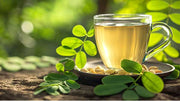Green Rooibos vs. Red Rooibos Tea: What is the Difference?

Rooibos tea, sometimes called “red bush tea,” has long been a cherished herbal tea in South Africa. It is now a global favorite thanks to its naturally caffeine-free profile, smooth taste, and wellness benefits. But did you know rooibos comes in two distinct varieties—red rooibos and green rooibos?
In this guide, we’ll dive into everything you need to know about green rooibos vs. red rooibos tea. You'll learn how they’re made, what they taste like, and the benefits each has to offer.
One Plant, Two Teas
Rooibos tea is made from the Aspalathus linearis shrub, grown only in South Africa’s Cederberg mountains. Though both teas originate from the same plant, their processing methods create unique flavors, colors, and even health-supporting properties.
Both red and green rooibos are naturally caffeine-free and full of antioxidants. Understanding the differences can help you choose the rooibos tea that best fits your taste and wellness goals:

- Red Rooibos Tea: Oxidized during processing, which turns the leaves a reddish-brown color producing a smooth, naturally sweet flavor.
- Green Rooibos Tea: Dried quickly to prevent oxidation, the leaves remain green. This gives the tea a lighter, fresher taste with more antioxidants.
Flavor: Sweet vs. Fresh
One of the biggest differences is taste:
- Red Rooibos: Rich, nutty, earthy, and slightly sweet. Often compared to black tea but naturally caffeine-free. Great with spices, vanilla, or chocolate.
- Green Rooibos: Crisp, grassy, and refreshing. Similar to green tea but without bitterness. Pairs well with fruit and floral blends.

Antioxidants and Health Benefits
Both teas are packed with antioxidants, but green rooibos usually has higher levels because it isn’t oxidized. The star antioxidant is aspalathin, unique to rooibos, which may help with blood sugar balance and inflammation.
Shared Benefits of Drinking Rooibos Tea:
- Heart Health: Supports healthy cholesterol and blood pressure.
- Blood Sugar: Green rooibos especially may help regulate blood sugar.
- Anti-Inflammatory: Can ease oxidative stress in the body.
- Digestion: Gentle on the stomach and caffeine-free.
- Skin Support: Antioxidants may help protect skin from aging.
- Stress & Sleep: Naturally calming and perfect as an evening tea.
For a deeper dive into the benefits of Green Rooibos, click here.
Leaves and Stems
Both leaves and stems of the rooibos plant are used in making tea. The leaves provide most of the antioxidants, while the stems add natural sweetness. Higher-grade rooibos uses more leaves and fewer stems for a richer flavor.
Brewing Tips
To bring out the best in each tea, adjust your water temperature and steeping time:
- Red Rooibos: Use near-boiling water (200–212°F) and steep for 5–7 minutes. Try with honey or milk for a cozy treat.
- Green Rooibos: Use slightly cooler water (175–185°F) and steep for 3–5 minutes. Delicious plain or with lemon.
Which One Should You Choose?
It really comes down to personal preference:
- Pick Red Rooibos if you like a sweeter, full-bodied tea with comforting depth.
- Pick Green Rooibos if you prefer a lighter, fresher flavor and want to maximize antioxidants.
Or enjoy both—green rooibos as a refreshing daytime tea and red rooibos as a calming evening drink.
Final Sip
When comparing green rooibos vs. red rooibos, the key difference is oxidation. Red rooibos offers a sweet, earthy richness, while green rooibos delivers a crisp, grassy taste with more antioxidants. Both are caffeine-free, healthy, and versatile—making rooibos a wonderful addition to your tea collection in either form.






